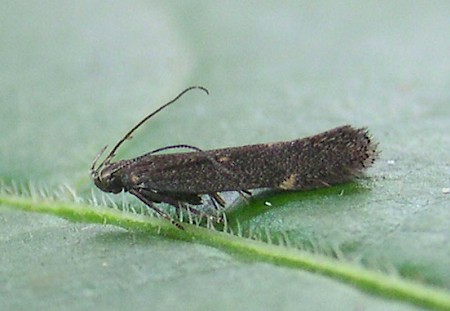35.010 BF843
Aproaerema anthyllidella
(Hübner, [1813])
Wingspan c. 11mm. A reasonably common species throughout most of the British Isles, though more local in Scotland, this species mainly inhabits dunes, dry grassland and rough pasture where kidney vetch occurs.
The intensity and extent of the creamy markings on the forewing can be variable, and they are sometimes absent altogether.
There are two generations, flying in May and June and again in August and September.
Larvae are usually stated to occur in April-May and July-August, but it is uncertain how the species overwinters. Early instar larvae can be found on A. vulneraria in September (1.25 mm- 2.3mm, pers. obs. I.F. Smith) and in January (MBGBI 4-2), and A. vulneraria plants covered with netting in November with undetected early larvae or ova had 2.5mm larvae the following March (pers. obs. I.F. Smith).
The main foodplant is kidney vetch (Anthyllis vulneraria), although other herbaceous plants growing in the same area may also be used, such as restharrow (Ononis spp. ) sanfoin (Onobrychis viciifolia), lucerne (Medicago sativa) and clover (Trifolium spp.). The first generation initially forms an unmistakable leaf mine on Anthyllis vulneraria, but the second generation feeds on the flowers. Feeding signs on other plants vary in appearance. Larvae can move between sewn leaves, and more than one larva may be found together.
Similar species (adults): 779 Bryotropha affinis has a bristle (pecten hair) at base of antenna which is absent in A. anthyllidella . Also consider 731a Eulamprotes immaculatella and 848 Syncopacma albipapella if specimens are not reared from larvae on an appropriate foodplant.
- Larva: (description Ian F. Smith):
Early instar
Length: 2.5 mm described
Head: Shining black.
Prothoracic shield: Dark brown with paler central area.
Thoracic legs: Dark brown.
Body: Dull reddish brown. Indistinct, discontinuous yellowish white dorsal line on thorax. Indistinct slightly darker dorsal line on segments A1-A7.
Pinacula: Small, black and indistinct, except larger black subdorsal pinaculum on segment A9.
Anal plate: Black.
Prolegs: Colourless. Anal prolegs with large blackish lateral sclerite.
Later instar
Length: 5.5 mm described
Head: Blackish brown. Frons and mouthparts brown.
Prothorax (T1): White anterior edge. Prothoracic shield: Dark brown and blackish divided by thin paler dorsal line.
Mesothorax (T2): As abdomen, but with pale greyish dorsal spot posteriorly. White intersegmental areas between it and T1 and T3, with brown interruptions dorsally.
Metathorax (T3): As abdomen, except slightly paler brown dorsally between T3 and A1.
Thoracic legs: Black.
Body: Segments A1-A7 dark brown, slightly purplish. A8-A9 paler, except for dark dorsal area on anterior half of A8. Whitish subspiracular patch at anterior of segments T2 - A8.
Pinacula: Small, black and indistinct, except larger black subdorsal pinaculum on segment A9.
Setae: White.
Anal plate: Black.
Prolegs: Coloured as body. Anal prolegs with large blackish sclerite.
Final instar, pre-pupation
Head: Pale greyish brown.
Prothorax (T1): Greyish white anterior edge. Prothoracic shield: Greyish with bold black mark at anterior and bordering the greyish dorsal line.
Mesothorax (T2): As abdomen. Prominent greyish white intersegmental areas between it and T1 and T3, without brown dorsal interruptions.
Metathorax (T3): As abdomen, with prominent grey intersegmental area between it and A1.
Thoracic legs: Black.
Body: Dull greyish with dull reddish brown patches dorso-laterally, laterally and sub-ventrally. Greyish white subspiracular patch at anterior of segments T2 - A8.
Pinacula: Small, black and indistinct, except larger black subdorsal pinaculum on segment A9.
Setae: White.
Anal plate: Black.
Prolegs: Coloured as body. Anal prolegs with large blackish sclerite.

 UKMoths
UKMoths 







